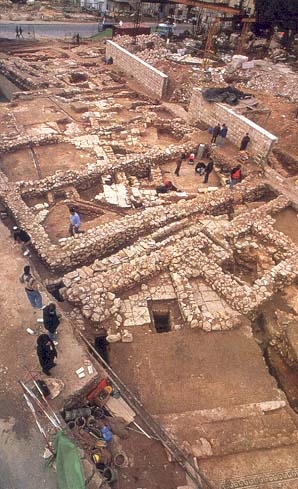Image Details

Israel Antiquities Authority
Roadblock. Before constructing Municipal Highway No. 1, which links the Old City with Jerusalem’s northern suburbs, city officials called in archaeologists, who uncovered this vast Byzantine monastic complex just 3 feet below the surface and directly in the path of the planned highway. Occupied from the fifth to the ninth century, the 375-foot-long complex included two hostelries, a large cemetery and four monasteries, the largest of which housed an Armenian community. The edges of the white stone pavement and mosaic floor of the Armenian church appear at the bottom of the photo. A rectangular hole in the ground, below center, leads to a burial crypt hewn from the rock.
“I Ewstat’ the priest laid this mosaic. (You) who enter this house, remember me and my brother Luke to Christ” reads an Armenian inscription from the floor of the monastery’s residence hall, dated by a coin to soon after 638 C.E. Until the recent excavations, the extent of this Byzantine monastic community was unknown, although archaeologists had previously discovered isolated Armenian remains near Damascus Gate, including the fabulous Bird Mosaic.
